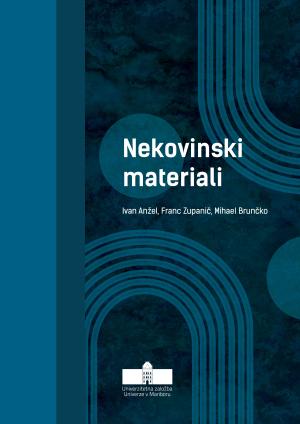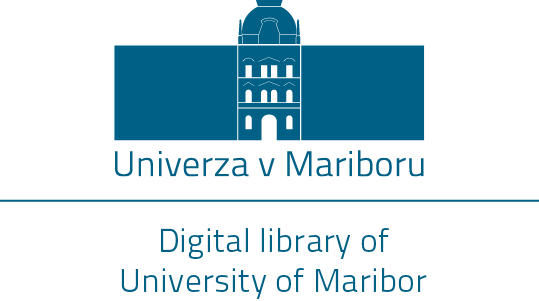Nekovinski materiali
Keywords:
non-metallic materials, polymers, ceramics, composites, structure, propertiesSynopsis
Non-Metallic Materials. In the script Non-Metallic Materials, students will explore the key aspects of the importance of non-metallic materials in modem engineering. These materials have become indispensable in many industries for designing and manufacturing products and, in some cases, are even fully replacing metals and alloys. The unique combination of their properties enables the development of technologically advanced solutions that are both energy-efficient and environmentally friendly. With the script Non-Metallic Materials, students will gain an indepth understanding of the structure, properties, and manufacturing technologies of polymeric, ceramic, and composite materials.
Downloads
References
[1] N. J. Mills: Plastics – Microstructure, Properties and Applications, Edward Arnold Ltd, London, 1986.
[2] I. Anžel, M. Brunčko, F. Zupanič, Sodobni inženirski materiali, Univerza v Mariboru, 2025.
[3] Georg Menges: Werkstoffkunde – Kunststoffe, 3. Auflage, Carl Hansen Verlag, München, Dunaj, 1990.
[4] Adolf Echte: Handbuch der Technischen Polimerchemie, VCH Verlagsgesellschaft mbH, Weinheim, New York, Basel, Cambridge, Tokio, 1993.
[5] Bernd-Joachim Jungnickel und 5 Mitautoren: Umformen von Kunststoffen im festen Zustand, Expert Verlag, 1988.
[6] M. F. Ashby: Materials Selection in Mechanical Design, Third Edition, Butterworth-Heinemann, Oxford, 2004.
[7] W. D. Callister: Materials Science and Engineering – an Introduction, 5th editon, John Wiley & Sons, Inc., 2000.
[8] R. J. Young, P. A. Lovell: Introduction to Polymers, 3rd edition, CRC Press, Boca Raton, 2011.
[9] J. M. G. Cowie, V. Arrighi: Polymers: Chemistry and Physics of Modern Materials, 3rd edition, CRC Press, Boca Raton, 2007.
[10] Ullmann's Encyclopedia, Ullmann's Polymers and Plastics, Wiley-VCH, 7th edition, Weinheim, 2016.
[11] D. Kyriacos, High-Temperature Engineering Thermoplastics, Brydson's Plastics Materials, 21, Elsevier, 2017, str. 545‒615.
[12] V. R. Sastri, Fillers (Including Fibers Reinforcements), Plastics in Medical Devices, 8, Elsevier, 2014.
[13] M. Žigon, Uvod v polimere, Ljubljana, 2009.
[14] R. E. Cameron, A. Kamvari-Moghaddam: Synthetic bioresorbable polymers, Cambrige, Woodhead Publishing Limited, 2012, str. 96‒118.
[15] F. Sarasini: Biocomposites for High-Performance Applications, Rim, Elsevier, 2017, str. 82‒123.
[16] S. Pilla: Handbook of Bioplastics and Biocomposites Engineering Applications, New Jersey, John Wiley & Sons, 2011.
[17] Michel Barsoum: Fundamentals of ceramics, McGraw-Hill, 1997.
[18] Drago Kolar: Tehnična keramika, I. in II. knjiga, Zavod Republike Slovenije za šolstvo in šport, 1993.
[19] W. E. Worrall: Clays and ceramic raw materials, 2th edition, Elsevier 1986.
[20] P. W. Atkins: Physical Chemistry, 4th edition, Oxford University Press, New York, 1990.
[21] D. W. Richerson: Modern ceramic engineering, Dekker, New York, 1982.
[22] J. E. Reed: Introduction to the principles of ceramic processing, Wiley, New York, 1988.
[23] G. Y. Onoda, L. L. Hench: Ceramic processing before firing, Wiley, New York, 1978.
[24] R. J. Borg, G. D. Dienes: The Physical Chemistry of Solids, Academic Press, New York, 1992.
[25] E. Krause, I. Berger, O. Krockel, P. Maier: Technologie der Keramik, B. 3, Thermische Prozesse, VEB Verlag für Bauwesen Berlin, 1985.
[26] J. Reed: Principles of Ceramic Processing, 2d edition, Wiley, New York, 1995.
[27] T. H. Courtney: Mechanical Behavior of Materials, McGraw-Hill, New York, 1990.
[28] A. Kelly, N. H. Macmillan: Strong Solids, 3d edition, Clarendon Press, Oxford, Anglija, 1986.
[29] R. W. Davidge: Mechanical Behavior of Ceramics, Cambridge University Press, New York, 1979.
[30] J. R. Taylor, A. C. Bull: Ceramics Glaze Technology, Pergamon Oxford, 1986.
[31] H. W. Chandler: Thermal Stresses in Ceramics, Trans. J. Brit. Cer. Soc. 191, 1981.
[32] A. J. Moulson, J. M. Herbert: Electroceramics, Chapman & Hall, London 1992.
[33] W. Krenkel: Ceramic matrix composites, Wiley-VCH, 7th edition, Weinheim, 2008.
[34] K. K. Chawla: Ceramic matrix composites, 2nd edition, Springer US, New York, 2003.
[35] H. Oettel, H. Schumann, Metallografie, 15. Auflage, Wiley-VCH Verlag, Wienheim, 2011.
[36] L. Kosec: Kompoziti, KZT, letnik 28, št. 1‒2, str. 19‒24, 1994.
[37] N. J. Mills: Plastics – Microstructure, Properties and Applications, Edward Arnold Ltd, London, 1986.
[38] G. Lojen: Sinteza tiksotropnih mešanic, doktorska disertacija, Fakulteta za strojništvo, Univerza v Mariboru, Maribor, 2002.
[39] W. F. Smith: Principles of Materials Science and Engineering, McGraw-HillBook Company, New York, 1986.
[40] I. Anžel: Notranja oksidacija hitro strjenih bakrovih zlitin, Naravoslovnotehniška fakulteta, Univerza v Ljubljani, Ljubljana, 1996.
[41] R. Rudolf, A. Križman: Analiza mikrostrukture kompozitov AlSi7-SiC, izdelanih po postopku tiksotropnega ulivanja, KZT, letnik 32, št. 3/4, 1998.
[42] M. Flemming, G. Ziegmann, S. Roth: Faserverbundbauweisen, Springer-Verlag, Berlin, Heidelberg, 1995.
[43] M. Taya, R. J. Arsenault: Metal Matrix Composites, Pergamon Press, Oxford, New York, 1989.
[44] R. W. Cahn, P. Haasen: Physical Metallurgy Part I, Part II, North-Holland-Physics Publishing, Amsterdam, Oxford, New York, Tokio, 1983.
[45] R. A. Flinn, P. K. Trojan: Engineering Materials and their Applications, John Wiley&Sons, 4th edition, 1995.
[46] B. Terry, G. Jones: Metal Matrix Composites, Elsevier Science Publishers Ltd. 1994.
[47] O. Schwarz: Kunststoffkunde, Vogel Buchverlag 2. Auflage, Wurzburg, 1987.
[48] T. W. Clyne, D. Hull, An Introduction to Composite Materials, Third Edition, Cambridge University Press, 2019.







